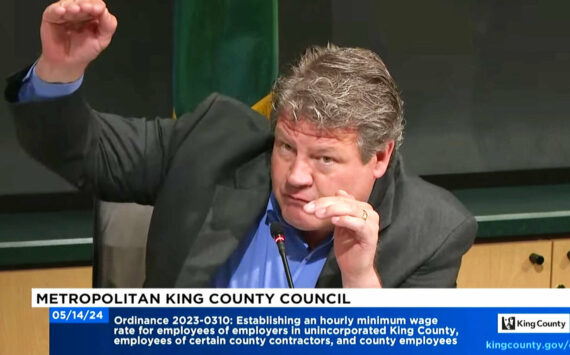Social movements are odd things. Pragmatic goals are rarely articulated, and ineffable vision serves as the only driving force behind large-scale social change. Martin Luther King’s “I Have a Dream” speech captured the aspirations of the civil rights movement and defined the activist’s role for years to come. In the annals of literature liberating us from patriarchy, everything from Simone de Beauvoir’s The Second Sex to Mary Pipher’s Reviving Ophelia articulates the feminist ideal of a patriarch-free world and blazes a trail for delivering feminist ideals to the real world. Even the men’s movement of the last two decades, however contorted and awry it appears to be, is elucidated by the visionary works of Robert Bly.
My fancies have yet to be captured by a leader’s vision for the gay movement. Just talking about the gay movement feels a little audacious. There’s no central processing unit, no clear common initiative, just a shared sense that things aren’t right and they aren’t going to change by themselves. And though I can point to clear moments in the past—the ’87 and ’93 marches on Washington, DC, or ACT-UP’s 1983 takeover of the FDA in Rockville, Maryland—there have been only a few times when I felt that the quality of my gay life had been greatly improved.
And yet things have changed in ways that a post-Stonewall queer baby who came of age in the middle of the AIDS epidemic, and who takes for granted being out to his family, friends, and community, can’t quite manage to see. Lesbians and gay men have come a long way in the past 30 years. In the ’70s, the gay community mobilized around sexual liberation and community pride. With the ’80s came the plague, fear, and an awakening of gay and lesbian political power that, come the early ’90s, was being flexed for everything from domestic partnership recognition to anti-discrimination laws and adoption rights.
The ’90s have been a wild ride for the queer community. We started out with Ronald Reagan’s not-so-different successor and ended with a president who, though tottering along the way, did more for the gay community than any of his predecessors. It’s the decade where we became post-everything: post-AIDS, post-Ellen . . . for a few months in 1998 some of us were even post-gay. And here we are 30 years after the Stonewall riots, the mythological start of it all, about to stagger into a new millennium with our wounds dressed. But what does that millennium hold?
Our recent victories have brought new battles. While 10 years ago we were fighting for our rights, we’re now fighting to keep those rights from being taken back. And we’re fighting with each other.
MY FIRST INTENT for this article was to survey gay and lesbian community leaders about what the ’90s meant to them. I set about interviewing people who played an important role in the movement these past few years. I asked them what the gay community’s great recent accomplishment was and what the next great challenge is. I expected to be told about moments in time when they were overcome with pride and satisfaction at a particular achievement. But I learned instead that the ’90s were not about moments; they were about the ends of eras and the uncertain beginnings of others. “In the past couple of years, we’ve won some battles and made some friends,” reflected Barbara Bailey, owner of Bailey/Coy Books on Broadway. “In Seattle, we’ve raised awareness but become complacent.” Bailey feels that the visibility gained by the community will serve us well, but that the community still needs a plan. “Right now, it seems that defining the issue is the issue.”
It doesn’t help that the community is getting harder to define. “It is not homogeneous,” said Seattle City Council member Tina Podlodowski. “There are a lot of growing pains in the Seattle community.”
Gay men, lesbians, bisexuals, and transgendered people never were a single community; rather, they were subgroups allied in the fight for political and social gain. Under the pressure of the AIDS crisis, the barriers between these groups were conveniently overlooked. Differences between men and women, or between people of different racial or ethnic backgrounds, were never fully explored, and mutual fears and suspicions never quite resolved.
The beginning of the epidemic saw many lesbians set aside the pursuit of their own issues and join the fight on behalf of their gay brothers. As the ’90s progressed and dollars for HIV prevention and AIDS services began flowing, the lesbian community returned its attention to its own issues—one of which was the gay family movement, pioneered by Podlodowski.
The councilwoman sees this issue becoming more central to the gay movement in the future. “Given the statements of George W. Bush on family, our children and families will be in the forefront in the next coming years,” she says. “How do we deal with institutions, like schools, not ready for children of gay parents?”
Steve Siefert, executive director of Lambert House, which provides gay and lesbian youth with social opportunities, also sees youth playing a vital role in the future of the movement. “The gay community needs to further enhance its involvement with youth and their families,” said Siefert. “Parents of young gay people need the gay community as a resource. Our education system needs to provide accurate information about diversity.”
WHILE THESE ARE important issues, they lack the galvanizing force necessary to create a broad coalition serving the interests of a diverse community. More and more, it seems as if the pursuit of one group’s issues alienates those of another.
These issues, for example—gay family-values issues, if you will—are oddly mainstream, and hardly the sort of issues likely to inspire the passion of more radically queer members of the community. Rachel Venning, co-owner of the sexy Toys in Babeland, feels the gay community’s diversity becomes most problematic when one part of the community gains ground and leaves another behind in the process. “We’ve made a lot of progress in getting accepted and having queerness become more normal,” she says, “but there’s a danger in making it safe for clean-cut, apple-pie homosexuals and passing over the others as just a bunch of freaky queers.” Venning feels the community needs to be more inclusive of subgroups, particularly transgendered people. Referring to postFreedom Day rancor about drag queens getting too much attention and presenting a distorting image of lesbians, gay men, and transgender folks, she says, “The whole idea that it makes us look bad is a problem.”
As groups begin to tackle their “own” issues, the coalitions formed during the AIDS crisis will begin to weaken and the community’s common galvanizing vision will fade. While the community may feel more fractured, we still may be able to progress in a proactive, goal-driven manner. I believe the gay movement will change and become more centered around questions about how individuals want to see their lives made better.
That doesn’t mean an end to coalitions. “We are no different than any other freedom movement. We will work for our needs,” says Marsha Botzer, a transgender activist and founder of the Ingersoll Center. “Individuals are always more interested in getting on with their lives, but they also have a connection to one another. Everybody asks, ‘Who am I?’ and ‘How do I fit into the world?'” That has been the question all along; here’s hoping that our search for a common answer will survive the move of so many of us into the mainstream.





